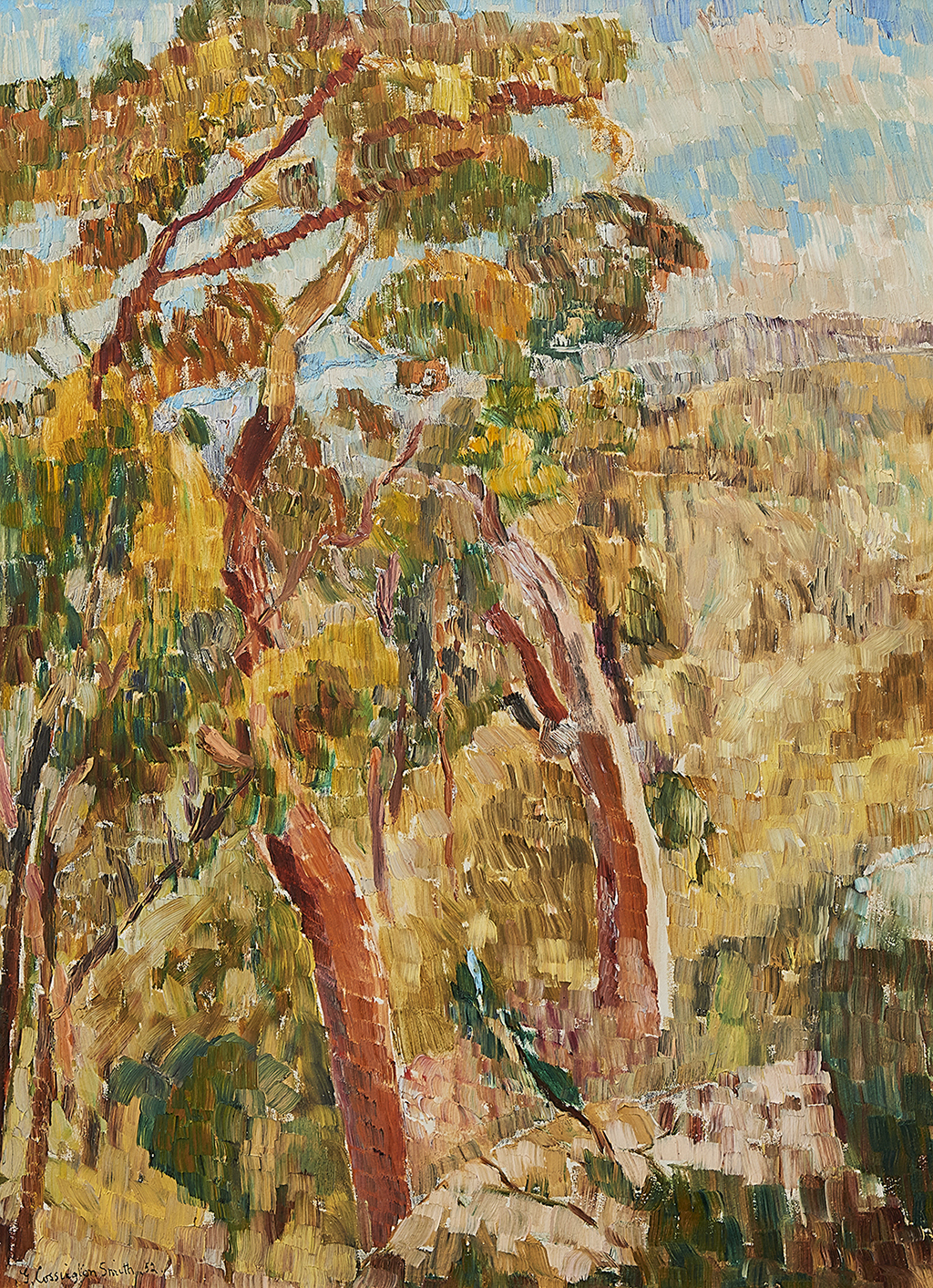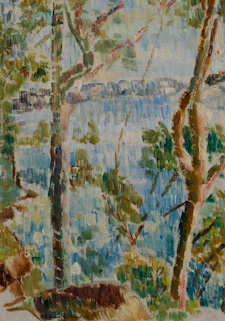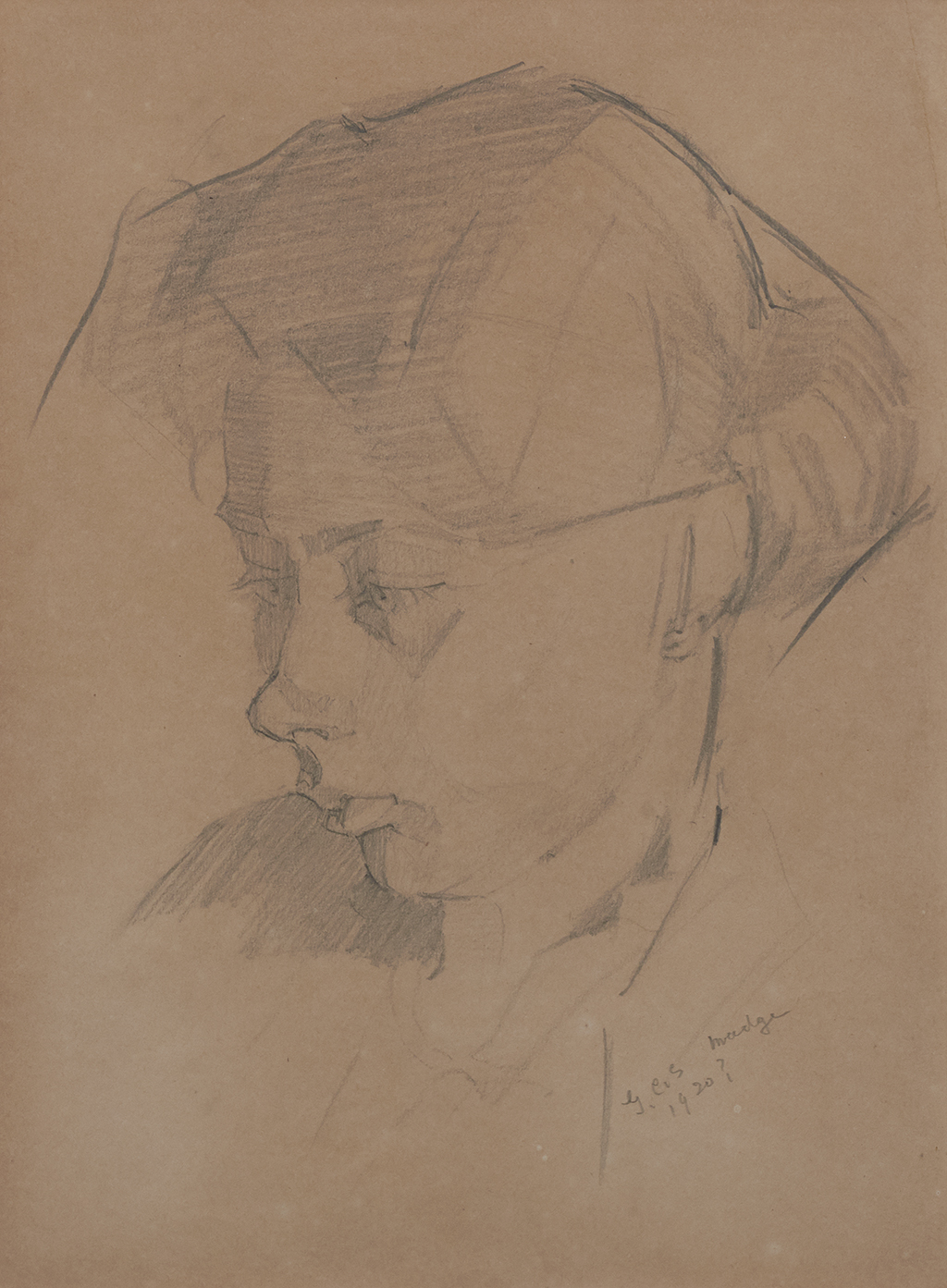Grace Cossington Smith (1892-1984)Thanksgiving Service, 1945-46
signed and dated lower right: 'G. Cossington Smith 46'
oil on pulpboard
65.5 x 48.5cm (25 13/16 x 19 1/8in).FootnotesPROVENANCE
Mr Christopher Davis, Sydney
The Fred and Elinor Wrobel Collection, Sydney
EXHIBITED
Contemporary Group, Farmer's Blaxland Galleries, 9 July 1946, as Thanksgiving Sunday
Grace Cossington Smith, Macquarie Galleries, Sydney, 29 May - 8 June 1968, cat. 4 dated as 1946
Grace Cossington Smith, Art Gallery of New South Wales, Sydney, 15 June - 15 July 1973; Queensland Art Gallery, Brisbane, 6 September - 4 October 1974; Western Australian Art Gallery, Perth, 6 December 1973 - 2 January 1974; Art Gallery of South Australia, Adelaide, 11 January - 10 February 1974; National Gallery of Victoria, Melbourne, 26 March - 28 April 1974, cat. 54 (label attached verso)
A Tribute to Grace Cossington Smith St. James's Church Hall, Turramurra, 21 - 23 November 1975, cat. 18
Sydney Through the Artist's Eyes 1840s - 1980s, Bicentennial exhibition, Woolloomooloo Gallery, Sydney, 1988, cat. 14
The Grace Cossington Smith Loan Exhibition, S.H. Ervin Gallery, Sydney, 18 October – 18 November 1990
Grace Cossington Smith: A Retrospective Exhibition, National Gallery of Australia, Canberra, 4 March - 13 June 2005; Art Gallery of South Australia, Adelaide, 29 July - 9 October 2005; Art Gallery of New South Wales, Sydney, 29 October 2005 - 15 January 2006; Queensland Art Gallery, Brisbane, 11 February - 30 April 2006 (label attached verso)
LITERATURE
Daniel Thomas, Grace Cossington Smith Art Gallery of New South Wales, Sydney, 1973, p. 45, cat. 54 (illus.)
James Bruce, Grace Cossington Smith Craftsman House, Sydney, 1990, p. 125 (illus.)
Catherine Speck, Painting Ghosts : Australian Women Artists in Wartime, Craftsman House, Melbourne, p. 194 (illus.)
Deborah Hart, Grace Cossington Smith National Gallery of Australia, Canberra, 2005, p. 67-70 (illus.), 179
RELATED WORKS
Church Interior, c.1941-42, oil with pencil on pulpboard, 55.2 x 42.2cm, in the collection of the Queensland Art Gallery, Brisbane
(Church Service [Part]), c.1947, coloured pencils on paper, 24.8 x 17.8cm, in the collection of the National Gallery of Australia, Canberra
(Sketches and notes for 'Thanksgiving service'), 1945, coloured pencil on paper, 36.8x 27.6, in the collection of the National Gallery of Australia, Canberra
Grace Cossington Smith's keen architectural interest is likely to stem from her 1912 voyage overseas with her sister Mabel and father, Ernest. They sailed on the Orvieto in March of that year from Sydney to England to visit family, as well as to reconnect with their English heritage. The last weeks of the voyage took them via Naples, Gibraltar and finally to Plymouth. Cossington Smith, who by then had already begun her artistic training under Dattilo-Rubbo, undoubtedly would have keenly observed and deeply admired the breathtaking architecture she encountered in Naples and then finally England where she would have several years to master her rendering of the fine buildings she saw.
Basing themselves in Winchester, the family travelled to various counties. In Sussex they visited Ernest's sister Charlotte in West Grinstead. She was an Anglican nun at St Margaret's Convent and it was here that Grace's interest in church architecture was further encouraged. Back in Winchester she would enrol in the Winchester School of Art and throughout her time abroad, compiled a collection of guide books, engravings plans, photos and postcards of provincial English churches and cathedrals of Britain and Europe.1
Ernest returned to Australia towards the end of 1912, while Grace and Mabel remained abroad until 1914. On their journey home, Mabel was to meet Captain Ridley Pakenham-Walsh whom she would marry in 1915 at St James, Turramarra, the setting for the current work. In fact, many family occasions were celebrated at the church as it was their local parish as residents of Turramurra from 1913. Whilst Grace and Mabel were still overseas, Ernest had moved the family from Bowral to Sylvan Fells, the home in Turramurra that would be Cossington Smith's residence for the next 60 years. She would later rename it Cossington.
Turramurra and its surrounds was a favoured subject of Cossington Smith. She painted numerous landscapes around the neighbourhood as well as two paintings of St James. The rebuilding of the church in 1941 'had been cause for much excitement for the artist's family and friends in Turramurra, with Ethel Anderson designing some of the stained glass windows'.2
Painted several years apart, Church Interior, 1942 and Thanksgiving Service 1945 present the scene from an almost identical perspective looking towards St James' altar with the artist placing herself behind the parishioners as an observer. However, there is a subtle difference in sentiment between them - in the 1942 work Deborah Hart observes, 'Missing are the men who had gone to war, giving an added poignancy to the image...In a later work, Thanksgiving Service 1945, the artist draws us closer to the altar and the large main archway, the re-installed flags signalling the end of the war. Again, there is a sense of quiet participation, now giving thanks in prayer for the end of the conflict. In the paintings Church Interior and Thanksgiving Service the stillness of the figures is counteracted by the expressive use of colour: more fresco-like in the former and more boldly applied touches of warmer, glowing hues in the latter, but both have a vitality and vibrancy in common with many of her works.'3
In Church Interior, 1942 and Thanksgiving Service 1945, 'the spaces of the church encapsulate war itself. The altar is a liturgical symbol of sacrifice. The vaulted apse points to the heavens...Cossington Smith now focuses on the metaphysical, spiritual and ultimately profound human impact on war survivors. Her focus on the stoic back views of the worshippers suggests grief is worldwide: this could be any congregation in any number of neighbourhoods.'4
Francesca Cavazzini
1.Bruce James Grace Cossington Smith Craftsman House, Sydney, 1990, p. 23
2. Deborah Hart (ed), Grace Cossington Smith National Gallery of Australia, Canberra, 2005, p. 68
Artist and writer, Ethel Anderson (the author of Seven Little Australians) had founded the Turramurra Wall Painters Group in 1929 which included Roy De Maistre and Roland Wakelin and had created a group of murals in the Children's Chapel in the crypt of St. James Church, Turramurra. She was a supporter of numerous modernist artist and was to become a promoter of Cossington Smith's work.
3. ibid.
4. Catherine Speck, Painting Ghosts: Australian Women Artists in Wartime, Craftsman House, Melbourne, 2004, pp. 193-194
Grace Cossington Smith (1892-1984)Thanksgiving Service, 1945-46
signed and dated lower right: 'G. Cossington Smith 46'
oil on pulpboard
65.5 x 48.5cm (25 13/16 x 19 1/8in).FootnotesPROVENANCE
Mr Christopher Davis, Sydney
The Fred and Elinor Wrobel Collection, Sydney
EXHIBITED
Contemporary Group, Farmer's Blaxland Galleries, 9 July 1946, as Thanksgiving Sunday
Grace Cossington Smith, Macquarie Galleries, Sydney, 29 May - 8 June 1968, cat. 4 dated as 1946
Grace Cossington Smith, Art Gallery of New South Wales, Sydney, 15 June - 15 July 1973; Queensland Art Gallery, Brisbane, 6 September - 4 October 1974; Western Australian Art Gallery, Perth, 6 December 1973 - 2 January 1974; Art Gallery of South Australia, Adelaide, 11 January - 10 February 1974; National Gallery of Victoria, Melbourne, 26 March - 28 April 1974, cat. 54 (label attached verso)
A Tribute to Grace Cossington Smith St. James's Church Hall, Turramurra, 21 - 23 November 1975, cat. 18
Sydney Through the Artist's Eyes 1840s - 1980s, Bicentennial exhibition, Woolloomooloo Gallery, Sydney, 1988, cat. 14
The Grace Cossington Smith Loan Exhibition, S.H. Ervin Gallery, Sydney, 18 October – 18 November 1990
Grace Cossington Smith: A Retrospective Exhibition, National Gallery of Australia, Canberra, 4 March - 13 June 2005; Art Gallery of South Australia, Adelaide, 29 July - 9 October 2005; Art Gallery of New South Wales, Sydney, 29 October 2005 - 15 January 2006; Queensland Art Gallery, Brisbane, 11 February - 30 April 2006 (label attached verso)
LITERATURE
Daniel Thomas, Grace Cossington Smith Art Gallery of New South Wales, Sydney, 1973, p. 45, cat. 54 (illus.)
James Bruce, Grace Cossington Smith Craftsman House, Sydney, 1990, p. 125 (illus.)
Catherine Speck, Painting Ghosts : Australian Women Artists in Wartime, Craftsman House, Melbourne, p. 194 (illus.)
Deborah Hart, Grace Cossington Smith National Gallery of Australia, Canberra, 2005, p. 67-70 (illus.), 179
RELATED WORKS
Church Interior, c.1941-42, oil with pencil on pulpboard, 55.2 x 42.2cm, in the collection of the Queensland Art Gallery, Brisbane
(Church Service [Part]), c.1947, coloured pencils on paper, 24.8 x 17.8cm, in the collection of the National Gallery of Australia, Canberra
(Sketches and notes for 'Thanksgiving service'), 1945, coloured pencil on paper, 36.8x 27.6, in the collection of the National Gallery of Australia, Canberra
Grace Cossington Smith's keen architectural interest is likely to stem from her 1912 voyage overseas with her sister Mabel and father, Ernest. They sailed on the Orvieto in March of that year from Sydney to England to visit family, as well as to reconnect with their English heritage. The last weeks of the voyage took them via Naples, Gibraltar and finally to Plymouth. Cossington Smith, who by then had already begun her artistic training under Dattilo-Rubbo, undoubtedly would have keenly observed and deeply admired the breathtaking architecture she encountered in Naples and then finally England where she would have several years to master her rendering of the fine buildings she saw.
Basing themselves in Winchester, the family travelled to various counties. In Sussex they visited Ernest's sister Charlotte in West Grinstead. She was an Anglican nun at St Margaret's Convent and it was here that Grace's interest in church architecture was further encouraged. Back in Winchester she would enrol in the Winchester School of Art and throughout her time abroad, compiled a collection of guide books, engravings plans, photos and postcards of provincial English churches and cathedrals of Britain and Europe.1
Ernest returned to Australia towards the end of 1912, while Grace and Mabel remained abroad until 1914. On their journey home, Mabel was to meet Captain Ridley Pakenham-Walsh whom she would marry in 1915 at St James, Turramarra, the setting for the current work. In fact, many family occasions were celebrated at the church as it was their local parish as residents of Turramurra from 1913. Whilst Grace and Mabel were still overseas, Ernest had moved the family from Bowral to Sylvan Fells, the home in Turramurra that would be Cossington Smith's residence for the next 60 years. She would later rename it Cossington.
Turramurra and its surrounds was a favoured subject of Cossington Smith. She painted numerous landscapes around the neighbourhood as well as two paintings of St James. The rebuilding of the church in 1941 'had been cause for much excitement for the artist's family and friends in Turramurra, with Ethel Anderson designing some of the stained glass windows'.2
Painted several years apart, Church Interior, 1942 and Thanksgiving Service 1945 present the scene from an almost identical perspective looking towards St James' altar with the artist placing herself behind the parishioners as an observer. However, there is a subtle difference in sentiment between them - in the 1942 work Deborah Hart observes, 'Missing are the men who had gone to war, giving an added poignancy to the image...In a later work, Thanksgiving Service 1945, the artist draws us closer to the altar and the large main archway, the re-installed flags signalling the end of the war. Again, there is a sense of quiet participation, now giving thanks in prayer for the end of the conflict. In the paintings Church Interior and Thanksgiving Service the stillness of the figures is counteracted by the expressive use of colour: more fresco-like in the former and more boldly applied touches of warmer, glowing hues in the latter, but both have a vitality and vibrancy in common with many of her works.'3
In Church Interior, 1942 and Thanksgiving Service 1945, 'the spaces of the church encapsulate war itself. The altar is a liturgical symbol of sacrifice. The vaulted apse points to the heavens...Cossington Smith now focuses on the metaphysical, spiritual and ultimately profound human impact on war survivors. Her focus on the stoic back views of the worshippers suggests grief is worldwide: this could be any congregation in any number of neighbourhoods.'4
Francesca Cavazzini
1.Bruce James Grace Cossington Smith Craftsman House, Sydney, 1990, p. 23
2. Deborah Hart (ed), Grace Cossington Smith National Gallery of Australia, Canberra, 2005, p. 68
Artist and writer, Ethel Anderson (the author of Seven Little Australians) had founded the Turramurra Wall Painters Group in 1929 which included Roy De Maistre and Roland Wakelin and had created a group of murals in the Children's Chapel in the crypt of St. James Church, Turramurra. She was a supporter of numerous modernist artist and was to become a promoter of Cossington Smith's work.
3. ibid.
4. Catherine Speck, Painting Ghosts: Australian Women Artists in Wartime, Craftsman House, Melbourne, 2004, pp. 193-194















Testen Sie LotSearch und seine Premium-Features 7 Tage - ohne Kosten!
Lassen Sie sich automatisch über neue Objekte in kommenden Auktionen benachrichtigen.
Suchauftrag anlegen